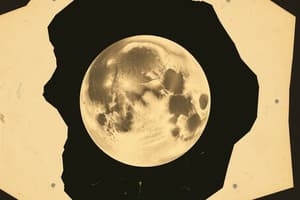Podcast
Questions and Answers
The New York Sun published articles about life on the moon on August 25, 1835.
The New York Sun published articles about life on the moon on August 25, 1835.
True (A)
Dr. Andrew Grant was a real scientist who discovered unicorns on the moon.
Dr. Andrew Grant was a real scientist who discovered unicorns on the moon.
False (B)
The articles from The New York Sun were initially believed to be true by many readers.
The articles from The New York Sun were initially believed to be true by many readers.
True (A)
The Edinburgh Journal of Science continued to publish articles after the hoax was revealed.
The Edinburgh Journal of Science continued to publish articles after the hoax was revealed.
Richard Adams Locke was one of the writers behind the hoax articles in The Sun.
Richard Adams Locke was one of the writers behind the hoax articles in The Sun.
The hoax was publicly admitted on September 16, 1835.
The hoax was publicly admitted on September 16, 1835.
Multiple newspapers across the country reprinted the moon articles without question.
Multiple newspapers across the country reprinted the moon articles without question.
The geography described in the moon articles included accurate scientific details.
The geography described in the moon articles included accurate scientific details.
Flashcards are hidden until you start studying
Study Notes
The Great Moon Hoax
- On August 25, 1835, The New York Sun published sensational articles claiming to report on scientific findings from the moon.
- The articles were attributed to Dr. Andrew Grant, a supposed colleague of astronomer Sir John Herschel, and claimed to be reprints from the Edinburgh Journal of Science.
- The articles gained immense popularity, sparking a desire for scientific news among readers across the United States.
Contents of the Articles
- Articles portrayed Herschel as having traveled to Capetown, South Africa, in January 1834 to set up an observatory with a powerful telescope.
- They described fantastical lunar life forms including unicorns, two-legged beavers, and human-like creatures.
- The moon’s geography was elaborately detailed with features like massive craters, amethyst crystals, flowing rivers, and lush vegetation.
Fabrication and Impact
- The entire series was a fabrication; Dr. Grant and the Edinburgh Journal of Science were fictional.
- The actual journal had ceased publication prior to the articles being printed.
- The lack of scientific basis for the findings did not deter public fascination and belief in the stories.
- Artists began recreating illustrations based on the articles, indicating public investment in the narratives.
Authorship and Revelation
- Richard Adams Locke is believed to be the real author behind the articles, known for his role as a reporter at The Sun.
- Locke crafted the stories with increasing absurdity, leading to widespread belief among readers.
- On September 16, 1835, The Sun officially admitted the articles were a hoax, marking an early instance of media deception.
Legacy
- This episode highlights the longstanding tendency for readers to be swayed by sensationalism in print media, a precursor to modern discussions on "fake news."
- It reflects a historical instance where writers aimed to entertain rather than inform, provoking a blend of wonder and skepticism in readers.
Studying That Suits You
Use AI to generate personalized quizzes and flashcards to suit your learning preferences.




